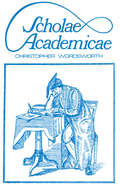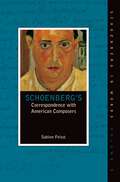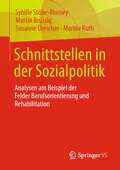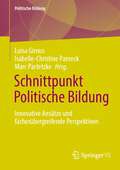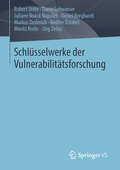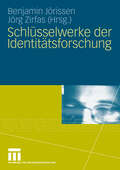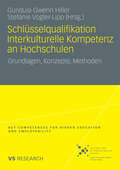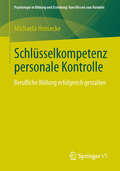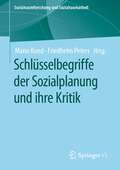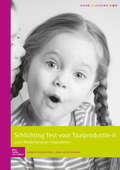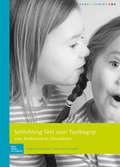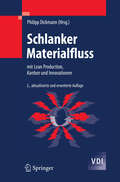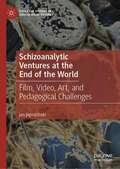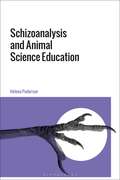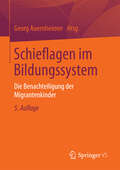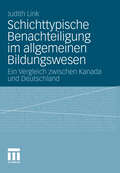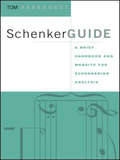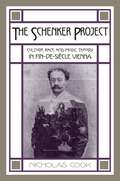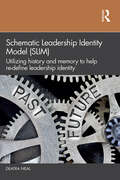- Table View
- List View
Scholae Academicae: Some Account of the Studies at the English Universities in the 18th Century (Cambridge Library Collection - Cambridge Ser.)
by Christopher WordsworthFirst published in 1968. Routledge is an imprint of Taylor & Francis, an informa company.
Scholae Academicae: Some Account of the Studies at the English Universities in the 18th Century
by Christopher WordsworthFirst published in 1968. Routledge is an imprint of Taylor & Francis, an informa company.
Schoenberg's Correspondence with American Composers (Schoenberg in Words)
by Sabine FeisstSchoenberg's Correspondence with American Composers is the first edition of all known and available letters between Arnold Schoenberg and over seventy American composers written between 1915 and 1951, in English and English translation and with commentary. In six chronologically organized chapters, the correspondence first casts new light on Schoenberg's contacts with American composers before 1933, including correspondence with students and champions of his music (Israel Amter, James Francis Cooke, Henry Cowell, Edgar Varèse, and Adolph Weiss among others). The letters after 1933 show how Schoenberg gradually built a network of composer colleagues and friends, among them Mark Brunswick, Oscar Levant, Roger Sessions, Nicolas Slonimsky, Gerald Strang, with whom he discussed compositional ideas, specific musical works and writings, performances and the publication of his compositions. These letters also provide insight into his ideas about teaching in private settings, at the Malkin Conservatory and the University of California. The correspondence of his last years illuminates how the reception of Schoenberg's music in the United States was flourishing and how he attracted a growing number of disciples exploring twelve-tone composition. The book also qualifies the concept of and Schoenberg's association with the Second Viennese School. Schoenberg's Correspondence with American Composers not only illuminates a varied and vivid epistolary style, but clearly demonstrates Schoenberg's far-reaching connections in the American music world.
Schoenberg's Correspondence with American Composers (Schoenberg in Words)
by Sabine FeisstSchoenberg's Correspondence with American Composers is the first edition of all known and available letters between Arnold Schoenberg and over seventy American composers written between 1915 and 1951, in English and English translation and with commentary. In six chronologically organized chapters, the correspondence first casts new light on Schoenberg's contacts with American composers before 1933, including correspondence with students and champions of his music (Israel Amter, James Francis Cooke, Henry Cowell, Edgar Varèse, and Adolph Weiss among others). The letters after 1933 show how Schoenberg gradually built a network of composer colleagues and friends, among them Mark Brunswick, Oscar Levant, Roger Sessions, Nicolas Slonimsky, Gerald Strang, with whom he discussed compositional ideas, specific musical works and writings, performances and the publication of his compositions. These letters also provide insight into his ideas about teaching in private settings, at the Malkin Conservatory and the University of California. The correspondence of his last years illuminates how the reception of Schoenberg's music in the United States was flourishing and how he attracted a growing number of disciples exploring twelve-tone composition. The book also qualifies the concept of and Schoenberg's association with the Second Viennese School. Schoenberg's Correspondence with American Composers not only illuminates a varied and vivid epistolary style, but clearly demonstrates Schoenberg's far-reaching connections in the American music world.
Schnittstellen in der Sozialpolitik: Analysen am Beispiel der Felder Berufsorientierung und Rehabilitation
by Sybille Stöbe-Blossey Martin Brussig Susanne Drescher Marina RuthSchnittstellen entstehen, wenn es für Menschen in sozialen Risikosituationen Hilfen von unterschiedlichen Institutionen gibt. Das Buch präsentiert empirische Ergebnisse zur Arbeit an Schnittstellen in den Feldern „Berufsorientierung“ und „Rehabilitation“ und legt einen übergreifenden Analyserahmen zur Gestaltung von Schnittstellen im entwickelten Sozialstaat vor.
Schnittpunkt Politische Bildung: Innovative Ansätze und fächerübergreifende Perspektiven (Politische Bildung)
by Luisa Girnus Isabelle-Christine Panreck Marc PartetzkeDie multiplen Krisenerscheinungen unserer Zeit bleiben nicht ohne Konsequenzen für die Politische Bildung, zu deren Zielen die Befähigung ihrer Adressat:innen zur kompetenten Teilnahme und Teilhabe am gesellschaftlichen Leben gehört. Insofern verwundert es denn auch nicht, dass sich die Praxis Politischer Bildner:innen aus ganz unterschiedlichen wissenschaftlichen Disziplinen speist. Der Band nimmt sowohl Schnittmengen der Politikdidaktik mit anderen wissenschaftlichen Disziplinen als auch die der Politischen Bildung mit anderen Domänen in den Blick und will die spezifischen Perspektiven auf die globalen Herausforderungen unserer Zeit in einen konstruktiven Austausch bringen.
Schlüsselwerke der Vulnerabilitätsforschung
by Robert Stöhr Diana Lohwasser Daniel Burghardt Markus Dederich Nadine Dziabel Moritz Krebs Jörg Zirfas Juliane Noack NapolesDas Buch bietet eine Einführung in die Zusammenhänge von subjektiven und strukturellen Momenten der Vulnerabilität und ihren pädagogischen Implikationen. Es greift auf Forschungen der Philosophie, Psychologie, Soziologie, Kultur- und Erziehungswissenschaft des 20. Jahrhunderts zurück, um zu verdeutlichen, welche Grundlagen, Auswirkungen, Formen und Entwicklungen von Verletzbarkeit und Fragilität von zentraler Bedeutung sind. Zugleich wird herausgearbeitet, welche pädagogischen Ansätze es ermöglichen, Vulnerabilitäten vorzubeugen, ihnen zu begegnen oder ihre Folgen zu bearbeiten. Strukturell orientiert sich das Buch an zentralen Autor*innen des 20. Jahrhunderts, denen nicht nur für ihre jeweilige Disziplin, sondern auch für den Vulnerabilitätsdiskurs insgesamt eine Schlüsselstellung zukommt.
Schlüsselwerke der Identitätsforschung
by Benjamin Jörissen Jörg ZirfasIdentität ist in der Moderne kein Geschenk, sondern eine Aufgabe. Die andauernde Debatte im Alltag und in den Wissenschaften zeigt, dass diese Aufgabe noch immer nicht leicht zu bewältigen ist, denn Identität muss immer noch aufgebaut, bewahrt und verteidigt werden. Der Band umfasst die wichtigsten Beiträge der Debatte um Identität im 20. Jahrhundert von Sigmund Freud bis zu Homi K. Bhabha. Die hier dargestellten Theoretiker der Identitätsforschung stellen für die Arbeit am Selbst die notwendigen analytischen und programmatischen Hilfsmittel zur Verfügung. Diese 'Schlüsselwerke' sind ein Buch für alle Sozial- und KulturwissenschaftlerInnen, die sich theoretisch und praktisch mit Identitätsfragen und Identitätskonzepten aus pädagogischer, soziologischer, psychologischer und philosophischer Perspektive auseinander setzen wollen.
Schlüsselqualifikation Interkulturelle Kompetenz an Hochschulen: Grundlagen, Konzepte, Methoden (Key Competences for Higher Education and Employability)
by Gundula-Gwenn Hiller Stefanie Vogler-LippWenn man den Titel dieses Handbuchs liest, möchte man aufatmen: „Endlich geht hier mal was voran! Das hat ja auch lange auf sich warten lassen!“ Tatsächlich setzt sich seit 20 Jahren in unserer Gesellschaft immer stärker die Erkenntnis durch, dass „Interkulturelle Kompetenz“ eine zentrale Schlüsselquali- kation in nahezu all den Tätigkeitsfeldern darstellt, in denen Führungsaufgaben zu übernehmen sind. Das betrifft natürlich vorrangig die Wirtschaft und die expo- orientierten Unternehmen, die ihr Personal nicht ohne ein Mindestmaß an int- kultureller Kompetenz in den Auslandseinsatz schicken wollen. Ebenso wichtig sind die beruflichen und außerberuflichen Tätigkeitsfelder in Deutschland, in denen es mehr oder weniger um ein produktives und zufriedenstellendes Zusammenleben von Menschen unterschiedlicher kultureller Herkunft geht. Wenn also die Erken- nis so weit verbreitet ist, dass interkulturelle Kompetenz für Fach- und Führun- kräfte so wichtig ist, und die Hochschulen die Aufgabe haben, die nachwachsende Generation auf die Bewältigung der mit der Internationalisierung und Globalis- rung einhergehenden Anforderungen vorzubereiten, dann müsste doch das Thema in der Hochschulausbildung eine führende Rolle spielen. Genau das ist aber nicht der Fall. So gibt es für eine Fülle von auf alle möglichen Zielgruppen speziell zugeschn- tenen Trainings zur interkulturellen Sensibilisierung und zum Aufbau interkultureller Kompetenz, aber bis heute gibt es kein interkulturelles Training für Wissenschaftler, die internationale Projekte durchführen oder in eben solche eingebunden sind. Womöglich liegt das daran, dass nach gängiger Meinung Wissenschaft schon immer international betrieben wurde und dass kulturelle Determinanten in diesem Ha- lungsfeld zu vernachlässigende Größen sind.
Schlüsselkompetenz personale Kontrolle: Berufliche Bildung erfolgreich gestalten (Psychologie in Bildung und Erziehung: Vom Wissen zum Handeln)
by Michaela HeineckeUnternehmen und ihre Mitarbeiter schauen heute hoffnungsvoll auf Schlüsselkompetenzen. Die Fähigkeit, sich weiterzuentwickeln, ist ausschlaggebend für den Erfolg ganzer Volkswirtschaften geworden. Was können Personalentwickler und Bildungsverantwortliche in der Aus-, Fort- und Weiterbildung dafür tun? Personale Kontrolle ist die Schlüsselkompetenz, die den Zugang schafft. Handlungsnah, ökonomisch und doch auf alle Lebensbereiche übertragbar, hilft Personale Kontrolle nicht nur beim Erreichen von Unternehmens- und Karrierezielen. Sie reguliert das selbständige Lernen im Alltag, beim Blended Learning und auch in Krisenzeiten. Empirische Studien zeigen außerdem: Wer personale Kontrolle gezielt fördert, der eröffnet den Weg in eine Erfolgsspirale des Lernens.
Schlüsselbegriffe der Sozialplanung und ihre Kritik (Sozialraumforschung und Sozialraumarbeit #23)
by Mario Rund Friedhelm PetersSozialplanung kann eine wichtige Grundlage für die Gestaltung der Lebensbedingungen in denen Städten, Kreisen und Regionen sowie für die Sicherung der kommunalen Daseinsvorsorge darstellen. Wie sie diese Funktion jedoch wahrnimmt, wird maßgeblich von ihren politisch-administrativen Einbettungen sowie ihren inhärenten Rationalitäten und Wissensbeständen bestimmt.Ihre diskursiv verfasste Praxis gilt es gesellschaftstheoretisch und -politisch zu verstehen und zu kontextualisieren. Hierzu möchte der vorliegende Band Anregungen bieten. Daher versammelt er 15 zentrale Begriffe mit denen das Professions- und Handlungsfeld erschlossen werden kann.Der InhaltBeratung – Digitalisierung – Geschlecht / Gender – Gleichwertigkeit – Governance – Integrierte Planung – Kommunale Sozialpolitik – Mobilität – Netzwerke – Partizipation – Sozialberichterstattung – Sozialraum – Sozialraumentwicklung – Steuerung – WirkungDie ZielgruppenLehrende und Studierende der Sozialen Arbeit, der Politik-, Kultur- und Verwaltungswissenschaften sowie der Architektur und der Raumplanung.Praktiker*innen der Sozialplanung, der Sozialen Arbeit, der Sozialraumarbeit, der Stadtteilarbeit, der Gemeinwesenarbeit, des Quartiermanagements u. Ä.Die HerausgeberDr. Mario Rund ist Professor für Soziale Arbeit im Gemeinwesen an der Hochschule Darmstadt.Dr. Friedhelm Peters ist em. Professor für Theorien Sozialer Arbeit an der Fachhochschule Erfurt und der Ev. Hochschule Dresden.
Schlichting Test voor Taalproductie - Handleiding: voor Vlaanderen en Nederland
by L. SchlichtingDoel van de testDe Schlichting Test voor Taalproductie - II meet het niveau van expressieve taalvaardigheid van jonge kinderen. De test bevat de volgende onderdelen:• Test voor Zinsontwikkeling: meet de actieve syntactische ontwikkeling dmv items waarmee een zin aan het kind wordt ontlokt. • Test voor Woordontwikkeling: meet de productieve woordenschat, door het benoemen van voorwerpen en plaatjes.• Verhaaltest: meet de spontane taalproductie van kinderen, waarbij het kind aan de hand van plaatjes een verhaaltje navertelt. • Test voor Auditief geheugen: meet het verbaal werkgeheugen dmv het nazeggen van eenlettergrepige woorden.• Pseudowoorden: meet de fonologische ontwikkeling van kinderen dmv het nazeggen van nonsenswoorden. Toepassing• Individuele diagnostiek: stelt de aanwezigheid van expressieve taalontwikkelingsstoornissen vast met het oog op behandeling, doorverwijzing naar het speciaal onderwijs of voor wetenschappelijk onderzoek.• Evaluatie: meet het effect van gegeven therapie.De Schlichting Test voor Taalproductie - II staat op de lijst van de Commissie Indicatiestelling (WAII) als aanbevolen test voor indicatiestelling voor het speciaal onderwijs (cluster-2) en leerlinggebonden financiering.Wat meet de Schlichting Test voor Taalproductie - II?Met de Schlichting Test voor Taalproductie - II kan de algemene taalvaardigheid van jonge kinderen in het domein van productie worden vastgesteld. De volgende gebieden worden getest:• Woordniveau• Zinsniveau• (Semi-) spontane taal• Verbaal werkgeheugen• Fonologisch werkgeheugen• Fonologische verwerkingVoor wie?De Schlichting Test voor Taalproductie - II wordt afgenomen door logopedisten, klinisch linguïsten en andere diagnostisch bevoegde professionals, zoals orthopedagogen etc. Afname en scoringDe Schlichting Test voor Taalproductie - II wordt individueel bij kinderen afgenomen. De afnameduur is ca. 30-60 minuten (afhankelijk van de leeftijd van het kind en het aantal afgenomen testonderdelen). Bij de testafname wordt volgens een gestandaardiseerde opzet een reactie aan het kind ontlokt door middel van het gebruik van afbeeldingen of voorwerpen. De verschillende testonderdelen kunnen elk apart worden afgenomen en leveren per onderdeel standaardscores op. Voor elk onderdeel gelden instap- en afbreekregels. Er wordt handmatig gescoord. De ruwe scores kunnen vervolgens handmatig worden omgezet of geautomatiseerd met behulp van Testweb.Belangrijk: u kunt deze test alleen afnemen indien u over Schlichting Test voor Taalproductie-II complete set beschikt.Normen De test is genormeerd op een representatieve steekproef van ca. 2200 Nederlands sprekende kinderen uit Nederland en Vlaanderen, verdeeld over de volgende leeftijdsgroepen: 1;9 – 2;3 – 2;9 – 3;3 – 3;9 – 4;3 – 5;3 – 5;10 – 6;6 – 7;3. In de handleiding wordt het Nederlandse en Vlaamse psychometrisch onderzoek beschreven. Voor Turks sprekende kinderen is een ongenormeerde Turkse versie van item 1 tot en met 40 van de Test voor Woordontwikkeling beschikbaar.Materiaal• Schlichting Test voor Taalproductie II – complete set• Schlichting Test voor Taalproductie II – scoreformulieren• Schlichting Test Turkse scoreformulieren• Schlichting Test voor Taalproductie II – handleiding
Schlichting Test voor Taalbegrip - Handleiding
by L. SchlichtingDoel van de testDe Schlichting Test voor Taalbegrip meet het receptieve taalniveau van jonge kinderen. De test is opgebouwd uit 7 secties die de ontwikkeling van het taalbegrip van jonge kinderen nauwkeurig volgen. Toepassing• diagnostiek: stelt de van aanwezigheid van receptieve taalontwikkelingsstoornissen vast met het oog op behandeling, aanvraag van leerlinggebonden financiering, doorverwijzing naar het speciaal onderwijs (cluster-2) of voor wetenschappelijk onderzoek.• Evaluatie: meet het effect van gegeven therapie.Wat meet de Schlichting Test voor Taalbegrip?Met de Schlichting Test voor Taalbegrip wordt de receptieve taalvaardigheid door middel van de volgende opdrachten vastgesteld: • Woordbegrip (aanwijzen van voorwerpen, uitvoeren van opdrachten met concreet materiaal en meerkeuzevragen.• Zinsbegrip• Complexe opdrachten. Voor wie?De Schlichting Test voor Taalbegrip wordt afgenomen door logopedisten, klinisch linguïsten, orthopedagogen en andere diagnostisch bevoegde professionals.Afname en scoringDe Schlichting Test voor Taalbegrip wordt individueel bij kinderen afgenomen. De afnameduur is gemiddeld 45 minuten (afhankelijk van de leeftijd van het kind). Bij de testafname wijst het kind volgens een gestandaardiseerde opzet de gevraagde voorwerpen aan of voert er handelingen mee uit. De test heeft instap- en afbreekregels. Belangrijk: u kunt deze test alleen afnemen indien u over de Schlichting Test voor Taalbegrip complete set beschikt.Normen De test is genormeerd op een representatieve steekproef van ca. 2200 Nederlands sprekende kinderen uit Nederland en Vlaanderen, verdeeld over de volgende leeftijdsgroepen: 1;9 – 2;3 – 2;9 – 3;3 – 3;9 – 4;3 – 5;3 – 5;10 – 6;6 – 7;3. In de handleiding wordt het Nederlandse en Vlaamse psychometrische onderzoek beschreven. Voor Turks sprekende kinderen is een ongenormeerde Turkse versie van sectie A tot en met D beschikbaar.Volgens de kwaliteitseisen van de WAII is de ’Schlichting Test voor Taalbegrip’ geschikt voor het gebruik bij indicatiestelling.Materiaal• Schlichting Test voor Taalbegrip – complete set• Schlichting Test voor Taalbegrip – scoreformulieren (set van 25)• Schlichting Test- Turkse scoreformulieren (set van 25)• Schlichting Test voor Taalbegrip – handleiding
Schlanker Materialfluss: mit Lean Production, Kanban und Innovationen (VDI-Buch)
by Philipp DickmannDas Buch beschreibt die Organisation des Materialflusses in einer schlanken Produktionsstruktur. Der Autor erläutert, wie die Hürden bei der Realisierung von KANBAN und Lean Production überwunden werden können. Besonders aufmerksam betrachtet er die Harmonisierung von schlanken Produktionssystemen sowie bestehenden betrieblichen EDV-Systemen und Strukturen im Controlling. Das Buch ist Referenzwerk und Leitfaden für die Praxis zugleich. Die 2. Auflage wurde aktualisiert, erweitert und um neue Beispiele und Abbildungen ergänzt.
Schizoanalytic Ventures at the End of the World: Film, Video, Art, and Pedagogical Challenges (Palgrave Studies in Educational Futures)
by jan jagodzinskiThis book provides a thorough application of theoretical ideas from Deleuze and Guattari to a series of examples drawn from contemporary film and new media arts. Chapters demonstrate examples of how to do schizoanalysis in philosophically informed cinema studies, new media, and arts based education. Schizoanalysis, as proposed by Deleuze and Guattari in distinction to Lacanian psychoanalysis, provides an imaginary basis to address the precarity of the contemporary world order: from the growing populism with its authoritarian fascist tendencies to the growing concerns regarding climate change within the Anthropocene. Part I of this book initiates this understanding through cinematic examples. Part II calls for a schizoanalytic pedagogical imagination, which is needed to provide insight into the structures of desire as they circulate in media, especially videogames, and the tensions between analogue and digital technological manifestations. Such pedagogy enables an understanding of the ‘new materialism’ where nonhuman and inhuman (AI) agencies are taken into account. To this end schizoanalytic pedagogy calls for a ‘new earth’ of transformed values and relationships.
Schizoanalysis and Animal Science Education
by Helena PedersenWithin the education system, acts of violence toward animals take place and are manifested on a routine basis in science classes, in lecture halls, in school canteens, and during study visits to zoos, farms, and slaughterhouses. Taken for granted as ”necessary” for teaching and learning, this violence profoundly affects animals as well as students. It also provides new entry points for understanding education as a multispecies power regime, driven by numerous other investments than knowledge dissemination alone. What, then, is the nature of this educational violence, and how exactly does education work through techniques of interference with student and animal bodies? Based on ethnographic research within upper secondary schools and higher education, this book challenges the use of animals in education by innovative engagement of Deleuze and Guattari's tool of schizoanalysis. Sparking a fundamental rethinking of educational processes, relations, and aims, the book explores how scientific knowledge about animals proliferates through complex interplay of power and desire in contested spaces of teaching and learning. Configuring animal science education as a set of machines working in tandem with the animal industry, Helena Pedersen offers radical new insights into how education forms subjectivities and social orders under conditions of capitalist expansion that capture students and animals alike. Bringing together education studies, science studies, critical animal studies, and continental philosophy, Pedersen also provides examples of disruptive action that can put education to work for transformation and liberation.
Schizoanalysis and Animal Science Education
by Helena PedersenWithin the education system, acts of violence toward animals take place and are manifested on a routine basis in science classes, in lecture halls, in school canteens, and during study visits to zoos, farms, and slaughterhouses. Taken for granted as ”necessary” for teaching and learning, this violence profoundly affects animals as well as students. It also provides new entry points for understanding education as a multispecies power regime, driven by numerous other investments than knowledge dissemination alone. What, then, is the nature of this educational violence, and how exactly does education work through techniques of interference with student and animal bodies? Based on ethnographic research within upper secondary schools and higher education, this book challenges the use of animals in education by innovative engagement of Deleuze and Guattari's tool of schizoanalysis. Sparking a fundamental rethinking of educational processes, relations, and aims, the book explores how scientific knowledge about animals proliferates through complex interplay of power and desire in contested spaces of teaching and learning. Configuring animal science education as a set of machines working in tandem with the animal industry, Helena Pedersen offers radical new insights into how education forms subjectivities and social orders under conditions of capitalist expansion that capture students and animals alike. Bringing together education studies, science studies, critical animal studies, and continental philosophy, Pedersen also provides examples of disruptive action that can put education to work for transformation and liberation.
Schieflagen im Bildungssystem: Die Benachteiligung der Migrantenkinder
by Georg AuernheimerPISA-Studien haben unübersehbar verdeutlicht, wie selektiv das deutsche Bildungssystem ist und wie stark es soziale Ungleichheit reproduziert. Kinder mit schlechten Startbedingungen, insbesondere Migrantenkinder, werden nicht ausreichend gefördert, wie der Leistungsstand von 15-Jährigen zeigt. Die 'Schieflagen im Bildungssystem', Interpretationen der PISA-Studien und bildungspolitische Schlussfolgerungen, werden in dieser Textsammlung diskutiert. Vor allem die Bildungssituation von Migrantenkindern wird ergänzend beleuchtet und verschiedene Erklärungsansätze geboten, um bildungspolitische und pädagogische Handlungsalternativen aufzuzeigen.
Schichttypische Benachteiligung im allgemeinen Bildungswesen: Ein Vergleich zwischen Kanada und Deutschland
by Judith Maria LinkSchenkerGUIDE: A Brief Handbook and Website for Schenkerian Analysis
by Thomas PankhurstSchenkerGUIDE is an accessible overview of Heinrich Schenker's complex but fascinating approach to the analysis of tonal music. The book has emerged out of the widely used website, www.SchenkerGUIDE.com, which has been offering straightforward explanations of Schenkerian analysis to undergraduate students since 2001. Divided into four parts, SchenkerGUIDE offers a step-by-step method to tackling this often difficult system of analysis. Part I is an introduction to Schenkerian analysis, outlining the concepts that are involved in analysis Part II outlines a unique and detailed working method to help students to get started on the process of analysis Part III puts some of these ideas into practice by exploring the basics of a Schenkerian approach to form, register, motives and dramatic structure Part IV provides a series of exercises from the simple to the more sophisticated, along with hints and tips for their completion.
SchenkerGUIDE: A Brief Handbook and Website for Schenkerian Analysis
by Thomas PankhurstSchenkerGUIDE is an accessible overview of Heinrich Schenker's complex but fascinating approach to the analysis of tonal music. The book has emerged out of the widely used website, www.SchenkerGUIDE.com, which has been offering straightforward explanations of Schenkerian analysis to undergraduate students since 2001. Divided into four parts, SchenkerGUIDE offers a step-by-step method to tackling this often difficult system of analysis. Part I is an introduction to Schenkerian analysis, outlining the concepts that are involved in analysis Part II outlines a unique and detailed working method to help students to get started on the process of analysis Part III puts some of these ideas into practice by exploring the basics of a Schenkerian approach to form, register, motives and dramatic structure Part IV provides a series of exercises from the simple to the more sophisticated, along with hints and tips for their completion.
The Schenker Project: Culture, Race, and Music Theory in Fin-de-siècle Vienna
by Nicholas CookToday we think of Heinrich Schenker, who lived in Vienna from 1884 until his death in 1935, as the most influential music theorist of the twentieth century. But he saw his theoretical writings as part of a comprehensive project for the reform of musical composition, performance, criticism, and education-and beyond that, as addressing fundamental cultural, social, and political problems of the deeply troubled age in which he lived. This book aims to explain Schenker's project through reading his key works within a series of period contexts. These include music criticism, the field in which Schenker first made his name; Viennese modernism, particularly the debate over architectural ornamentation; German cultural conservatism, which is the source of many of Schenker's most deeply entrenched values; and Schenker's own position as a Galician Jew who came to Vienna just as fully racialized anti-semitism was developing there. As well as presenting an unfamiliar perspective on the cultural and political ferment of fin-de-siècle Vienna, this book reveals how deeply Schenker's theory is permeated by the social and political. It also raises issues concerning the meaning and value of music theory, and the extent to which today's music-theoretical agenda unwittingly reflects the values and concerns of a very different world.
The Schenker Project: Culture, Race, and Music Theory in Fin-de-siècle Vienna
by Nicholas CookToday we think of Heinrich Schenker, who lived in Vienna from 1884 until his death in 1935, as the most influential music theorist of the twentieth century. But he saw his theoretical writings as part of a comprehensive project for the reform of musical composition, performance, criticism, and education-and beyond that, as addressing fundamental cultural, social, and political problems of the deeply troubled age in which he lived. This book aims to explain Schenker's project through reading his key works within a series of period contexts. These include music criticism, the field in which Schenker first made his name; Viennese modernism, particularly the debate over architectural ornamentation; German cultural conservatism, which is the source of many of Schenker's most deeply entrenched values; and Schenker's own position as a Galician Jew who came to Vienna just as fully racialized anti-semitism was developing there. As well as presenting an unfamiliar perspective on the cultural and political ferment of fin-de-siècle Vienna, this book reveals how deeply Schenker's theory is permeated by the social and political. It also raises issues concerning the meaning and value of music theory, and the extent to which today's music-theoretical agenda unwittingly reflects the values and concerns of a very different world.
Schematic Leadership Identity Model (SLIM): Utilizing History and Memory to Help Re-define Leadership Identity
by Deatra L NealA workbook for leaders who desire to be more effective and deliberate in their leadership identity and for young leaders coming into their own, this book introduces a unique two-step process to understand and define your leadership identity. While some leadership frameworks operate under static concepts of what makes a good leader, the Schematic Leadership Identity Model (SLIM) offers new and seasoned leaders an opportunity to explore the anchoring of who they are and the ebbs and flows of their attitudes and behaviors through life’s changes and experiences. The SLIM framework has two main footings of its seven phases: revolution, which is the recognition of one’s identity journey, and the theoretical constructs that help frame the process and evolution, a series of assignments and journal entries that helps each leader acknowledge their current leadership identity, unravel habits and behaviors that may not align with their idealized self, and redefine their leadership identity based on their findings and whom they aspire to be. The evolutionary design is a system necessary to be revisited as a leader goes deeper into their memories and experiences. This framework helps unearth unconscious and implicit biases that can hinder a leader’s social and cultural capital. No matter the industry or discipline, SLIM offers leaders a self-guided process of discovery that can profoundly examine the root causes of behaviors and attitudes to create meaningful change within themselves that can produce significant positive changes in their teams and organizations.
Schematic Leadership Identity Model (SLIM): Utilizing History and Memory to Help Re-define Leadership Identity
by Deatra L NealA workbook for leaders who desire to be more effective and deliberate in their leadership identity and for young leaders coming into their own, this book introduces a unique two-step process to understand and define your leadership identity. While some leadership frameworks operate under static concepts of what makes a good leader, the Schematic Leadership Identity Model (SLIM) offers new and seasoned leaders an opportunity to explore the anchoring of who they are and the ebbs and flows of their attitudes and behaviors through life’s changes and experiences. The SLIM framework has two main footings of its seven phases: revolution, which is the recognition of one’s identity journey, and the theoretical constructs that help frame the process and evolution, a series of assignments and journal entries that helps each leader acknowledge their current leadership identity, unravel habits and behaviors that may not align with their idealized self, and redefine their leadership identity based on their findings and whom they aspire to be. The evolutionary design is a system necessary to be revisited as a leader goes deeper into their memories and experiences. This framework helps unearth unconscious and implicit biases that can hinder a leader’s social and cultural capital. No matter the industry or discipline, SLIM offers leaders a self-guided process of discovery that can profoundly examine the root causes of behaviors and attitudes to create meaningful change within themselves that can produce significant positive changes in their teams and organizations.
